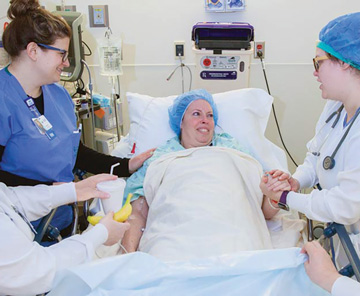The gradual movement toward eliminating opioids from the care plan of total joint patients is similar to the steady migration of the procedures from inpatient hospitals to outpatient ORs, according to Vinod Dasa, MD, a professor of clinical
orthopedics and clinical research at LSU Health New Orleans School of Medicine. His journey to same-day joint replacements began in 2013. Since then, he’s been tweaking and improving the protocols he uses to improve outcomes, including
the techniques he employs to ensure patients recover in comfort.
In 2019, Dr. Dasa began to reduce the number of opioids he prescribed to his patients and saw they recovered extremely well from surgery. He knew that going opioid-free was possible, but he needed an opportunity to incorporate the concept
into everyday practice. It came during the pause of elective surgeries at the height of the pandemic, which allowed him to hit the reset button on his pain management protocols. “I informed my team that we were going to stop prescribing
opioids when procedures resumed,” says Dr. Dasa. “And we did it. The sky didn’t fall. The world kept spinning.”
Dr. Dasa decided to track outcomes for the first 40 total knee patients he operated on after the restart of surgeries and reported on the results for a case series study he recently published. Of the 32 patients who were opioid-naïve,
26 (about 85%) needed only acetaminophen and NSAIDs after surgery for effective pain control. The patients who did request medications to treat breakthrough pain were given tramadol, a less potent opioid than oxycodone. When those outcomes
are factored into the study’s results, Dr. Dasa says about 95% of the patients did not require a powerful narcotic to keep their pain under control. The results validated his push for opioid-free knee replacements — arguably
one of the most painful procedures patients undergo.
No one can argue that the indiscriminate use of opioids to manage post-op pain jeopardizes safe patient care, but changing the prescribing patterns of surgeons remains a challenge. Dr. Dasa says most physicians understand the importance of
limiting opioid use at a high level, but don’t do it on a daily basis. “There’s no incentive other than perhaps goodwill and an understanding that the national epidemic is a major issue,” he says. “Surgeons
often think someone else will address the problem and continue to prescribe opioids.”
Dr. Dasa and his colleagues are currently working with basic scientists, anatomists, physiologists and neuroscientists to create an opioid mitigation initiative curriculum specifically designed for surgeons with the goal of creating a patient-centric
approach to perioperative care. The program, which involves didactic teaching and cadaver workshops to improve surgeons’ understanding of neuroanatomy and pain pathways, covers all aspects of opioid-reducing strategies throughout
the entire episode of care. The program is targeting surgical residents — a captive audience and a new generation of providers who will hopefully enter practice with a fresh approach to post-op pain management — but surgeons
of all levels of experience are invited and encouraged to participate.
Dr. Dasa says the educational sessions are effective and inspiring. “Specialists from numerous disciplines participate in fascinating and informative conversations about different aspects of patient care,” he explains. “You
can see the wheels turning, and light bulbs going off. We’re all learning from each other.”
.svg?sfvrsn=be606e78_3)

.svg?sfvrsn=56b2f850_5)